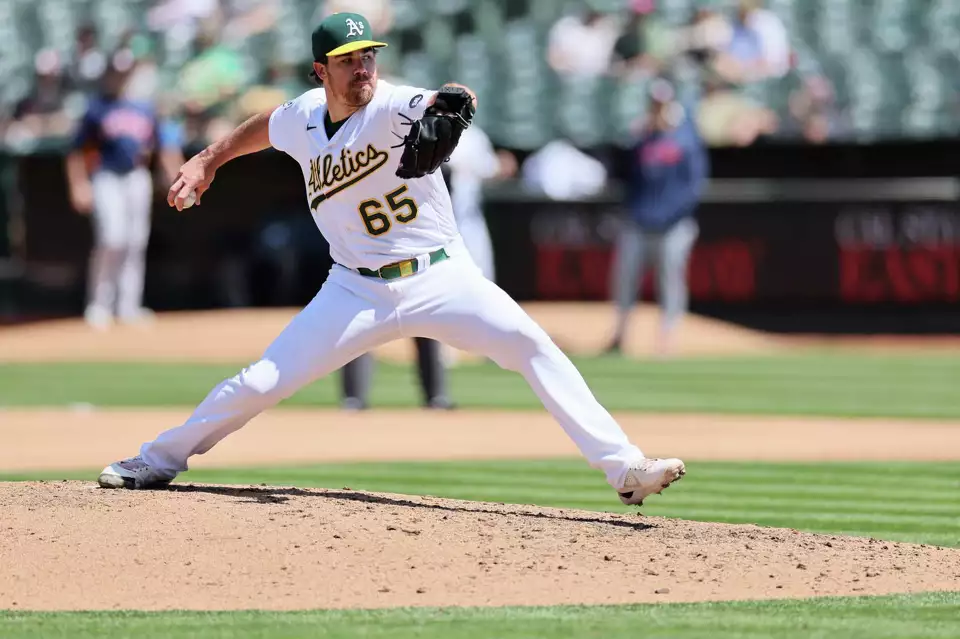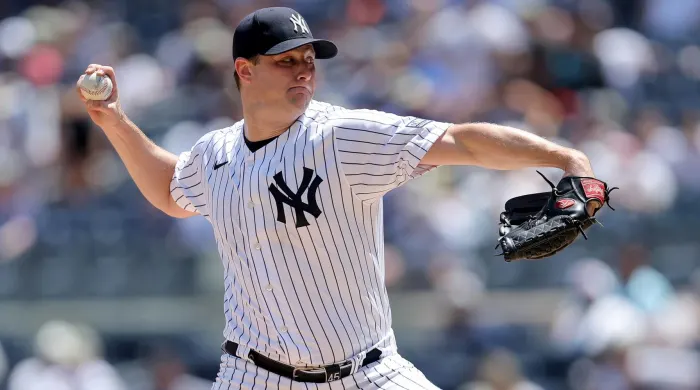Trevor May credits his anxiety for helping him last so long in the majors. If not for that unease he feels whenever he steps on the mound, he couldn’t have gone from raw pitching prospect to the Oakland Athletics’ highest-paid player.
“You have to be uncomfortable to be successful,” May, 34, said last month. “Being stressed creates energy. Otherwise, you just get kind of bored.”
Over his first eight years in the big leagues, May became a master at channeling his anxiety. Then MLB introduced a clock this season that gives pitchers 15 seconds to start their delivery with the bases empty and 20 seconds with a runner aboard. Suddenly, May didn’t have time for the crutches he had long used to manage his nerves: stepping off the rubber several times per batter, shaking off signs from the catcher, checking runners.
His routine disrupted, he became so consumed by self-doubt that he contemplated retirement. Now, little more than four months removed from a five-week stint on the injured list with what his team called “issues related to anxiety,” May isn’t just the A’s unquestioned closer — he is an inspiration.

Santiago Mejia/The Chronicle
Messages from fans flood his Twitter and Instagram accounts thanking him for speaking out about his anxiety. From time to time, teammates or opponents tell May that they have dealt with similar mental-health challenges. He feels good knowing that stories like his have helped ease the fear many in baseball have about being vulnerable.
Just 2½ years ago, after MLB saw a spike in players retiring in their prime, Sports Illustrated reported that more than a dozen big-leaguers were on the restricted list with mental-health-related issues. This spoke to a lingering stigma around the topic. By then, players had been allowed for several years to go on the IL for their mental health while maintaining the same benefits as active players, only for many to instead forgo pay and health services so they could keep their privacy on the restricted list.
Some players reportedly went on the IL with made-up injuries to avoid having to admit their personal challenges. But spurred in part by a pandemic that spotlighted a surge in depression and anxiety throughout the United States, MLB has experienced a mental-health awakening.
The league’s latest collective bargaining agreement mandates that all 30 teams employ at least one mental-health professional. With many franchises now expanding their mental-health programs far beyond the minimum requirements, some players have come to view therapy as no different than injury rehab.
It’s no coincidence, then, that more big leaguers are going on the IL with anxiety and other mental-health-related issues. This season, four players were added to the IL for mental health: May, Colorado’s Daniel Bard, Baltimore’s Jorge Lopez and Detroit’s Austin Meadows.
Like May, Bard and Lopez returned to the mound after reworking their pitching routines during relatively short IL stays. Meadows, an outfielder, stepped away from the Tigers after six games to treat anxiety and was recently ruled out for the rest of the season.
With the Centers for Disease Control and Prevention reporting that one in five Americans experience a mental illness each year, it’s fair to assume that well more than four of the roughly 750 players in MLB deal with issues like depression and anxiety. Still, May, Bard, Lopez and Meadows have represented important progress for the often-macho world of pro baseball.
“I think the pandemic created a new level of urgency for us to talk about mental health because it was really in our faces,” said Ben Strack, a licensed sports psychologist who serves as the A’s director of mental health. “It’s not that we’re necessarily seeing more players dealing with mental-health issues. We’re just seeing more guys who are willing to talk about it.”
Added A’s manager Mark Kotsay: “Anxiety has always existed in sports. … When I was coming up, players were less likely to discuss it. Now they’re a little more open about those things, which I think is a great sign of growth.”
Kotsay played his final big-league game in 2013, just four years after the New York Times published a story questioning players who missed games with social anxiety disorders. One psychiatrist who worked with the Mets suggested that some players could be “finding an excuse for why (their) performance isn’t what it was before.”
To this day, some big-leaguers worry about how they’ll be perceived if they go on the IL for anxiety. Would a team pass on a player with a history of mental-health issues? And even if an MLB general manager didn’t care, what would other players think?
May once pondered similar hypotheticals. But when he saw more of his peers discuss their issues with anxiety publicly, he began to feel less alone.

Scott Strazzante/The Chronicle
On April 8, in response to a tweet about Bard and Meadows going on the IL with anxiety, May tweeted: “Happy these guys took the step to get right. Bard tried the ‘tough it out’ route 10 years ago and learned that it (isn’t) the way. Hope they can find the joy that makes ball so great again soon.” The next morning, May awoke with an overwhelming sense of dread.
Worst-case scenarios raced through his mind. As May rode to the ballpark on that Sunday in mid-April, he recognized the tension in his muscles.
In the bottom of the sixth inning, with the A’s down 7-0 to the Rays, Kotsay summoned May from the bullpen. Before getting pulled, he walked four of the seven batters he faced. It was May’s first time walking four hitters in an inning since his MLB debut with the Twins in August 2014.
As he plodded to the dugout, he knew his career was in peril. Self-doubt, a pitcher’s biggest enemy, had crept to the front of May’s psyche. Instead of letting instinct drive his throwing motion, he fretted over the five seconds the new clock had trimmed from his usual routine.
In the past, when he felt himself losing control, May would just step off the rubber and gather his thoughts. But because of a new rule that allowed pitchers to leave the rubber just twice per batter, he had no clear way to cope.
And MLB’s efforts to speed up play weren’t May’s only problem. Though he declined to offer specifics, he conceded that he was dealing with some family matters at the time.
There was also the burden that comes with having the A’s biggest salary at $7 million. A low-profile reliever much of his career, May was brought in to lead a young bullpen — a responsibility he took seriously.
“I was about as overwhelmed as I’ve ever been,” May said. “I needed a wake-up call.”

Santiago Mejia/The Chronicle
Just as May was beginning to consider retirement, he met with Strack, who put his situation in perspective: Quitting wouldn’t solve May’s issues. If anything, it would make things worse because he would have regrets.
When May went on the IL for anxiety on April 19, he had a 12.00 ERA and hitters were batting .357 against him. Over the next month-plus, he spoke with Strack almost daily, identifying the root of his self-doubt and working to rebuild his confidence. May journaled and meditated each morning. During long conversations with catcher Shea Langeliers, May overhauled his pitching routine.
“It started with just trying to get the pitch in as quickly as possible to give him as much time as he needed,” Langeliers said. “But more than anything, it was just helping him use his perfectionism to his advantage. When he came back, he was like a different player.”
With his velocity down slightly on his four-seam fastball, May has relied more on his slider and changeup to keep hitters guessing. The result is the best stretch of his career. Since he returned from the IL in late May, he has converted 21 of 23 save opportunities, including a streak of 13⅔ innings and counting without allowing an earned run. Entering Thursday, May’s 1.29 ERA since July 18 ranked 11th in MLB among relievers in that span.
By nearly doubling his career saves total this season, he has positioned himself for his first multiyear contract. Odds are that May will be out of the A’s price range come free agency. But as Oakland enters its final series Friday of another 100-loss season, its fans can take comfort knowing that at least one player left a legacy that will extend beyond the field.
May has detailed his journey with anxiety to several media outlets in recent months. In doing so, he made one thing obvious: Pro baseball players aren’t so different from their fans.
Research suggests that about a third of U.S. adults have an anxiety disorder at some point in their lives. That number is even higher for people who work stressful jobs.
May’s livelihood hinges on his ability to thrive under the most pressure-packed circumstances. To do that consistently, he must embrace his anxiety — not fear it.
“Anxiety has fueled my career,” May said. “You got to make friends with it. It doesn’t have to be such a bad thing.”



